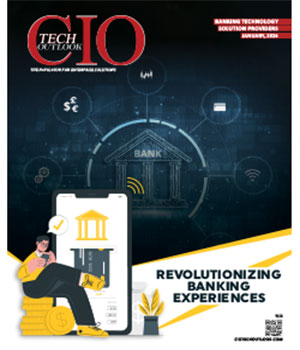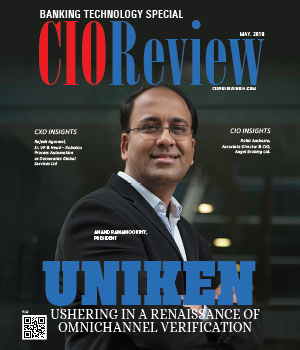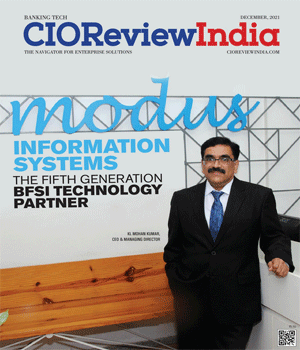
The Age of Digital Banking
Sangy Vatsa, EVP & CIO, Comerica Bank [NYSE:CMA] | Wednesday, 11 October 2017, 05:06 IST
 Over the course of last few years, relevance of technology and as a result, the role of a CIO in the banking sector have both been elevated. In my view, the following five major factors have contributed to this change.
Over the course of last few years, relevance of technology and as a result, the role of a CIO in the banking sector have both been elevated. In my view, the following five major factors have contributed to this change.
First, there has been a fast emergence of “Digital First” demand by consumers. Second, there now exists a rich eco-system of advanced data analytics which has been enabled by open-source technologies and crowd-sourcing delivery models. Third, a wide range of Fintech offerings have emerged. Most of these capabilities were born in the digital era and have been challenging the banking status quo. At the same time, many progressive banks are embracing this as a growth opportunity by investing in digital, increasing customer loyalty, and attracting the next wave of millennial customers. Fourth, there is fast growing cyber threat coupled with emergence of cybersecurity technologies to mitigate these issues. Finally, the presence of technology-savvy talent across divisions of banks is creating a healthy dialog amongst stakeholders to deliver digital products faster. The CIO is in the middle of this transformation and is co-shaping, co-leading and co-delivering this change for the external customers of the company in collaboration with major business stakeholders.
The ‘Two-in-a-Box’ Model
I believe creating awareness about the importance of IT begins with establishing genuine collaboration between CIOs and their business counterparts. The CIOs and their technology organizations have to demonstrate working knowledge of business domains and business priorities before they introduce compelling technology solutions. The business counterparts and their organizations too have to embrace the basic understanding of the evolving technology landscape. Once this cross-knowledge is in place, a business-savvy technology leader and a technology-savvy business leader are ready to anticipate customer needs and co-create “out-of-the-box” experience to delight their customers. This construct focuses on co-creation of Minimal Viable Products (MVPs) that can significantly speed up product delivery, while drastically cutting delivery cost. We refer to this collaboration framework as a “Two-in-a-Box” co-creation model. The user-centered design ensures that what is being designed and developed is market-driven and consumer-validated. While the focus on systems availability, cybersecurity, and financial performance is prime, such approaches that the CIOs are taking are enabling the shift from “IT as a cost center” to “Technology as an enabler of business transformation.”
Today’s banking universe is inundated with a wide range of emerging trends that include advanced analytics, software-defined computing, mobile platforms, advanced biometrics, legacy modernization, and technologies like Internet of Things and Blockchain. I have, however, been impressed by the pace at which technologies like machine learning and artificial intelligence are transforming the banking sector. A horde of opportunities exist to employ these two technologies to transform customer acquisition, customer loyalty, fraud management, and talent management.
A few major changes have been triggered by the emerging needs of our customers and the growing capabilities of the bank. Our customers are demanding digital capabilities. The digital personas of our retail and corporate customers are converging. Our colleagues are becoming passionate to deliver digital capabilities for our customers. These trends have shaped our guiding principle which focuses on delivering customer-centric products and services with speed and agility, and with embedded security and compliance, at an optimal cost by empowering our talent.
With this guiding principle as the foundation we have seen three major shifts. First, we have established a new technology strategy for the bank that we have named TechVision 2020. It has priorities centered on transforming our future, while strengthening our core. Second, we have reorganized ourselves by domains and shared services to increase accountability to drive business outcomes. The domains are a collection of products and applications in a business domain like Payments and Deposits. The Shared Services teams are responsible for core platforms and services that optimize capabilities across domains. Finally, we have launched a multi-phased operating model that is delivering value iteratively in line with the multi-year direction. Some of the major changes include agile delivery, continuous experiment at ion, development of talent and culture, technology investment management, financial performance and risk management.
Speedy Delivery of IT
I will summarize the four key actions that are underway to deliver faster. First, we are shifting the focus from funding mega-size multi-year technology programs to fund a series of customer-centric MVPs. The funding for the next set of MVPs will be gated based on performance of previous MVPs. Second, we have been rapidly introducing automation and leveraging new technologies like big data, robotics, biometrics, and systems management tools to address issues at a much faster pace. Third, we have started investing in an Application Programming Interface (API) framework to enable “plug-and-play” integrations with software product providers. Finally, with strong focus on agile practices, like DevOps, we are integrating important steps like code security assessments and release certifications into the core software engineering practice.
While we are making progress in these areas, these changes are challenging and require continued fostering of culture and investment in talent to further mature faster delivery.
A Pep Talk with Tomorrow’s CIOs
Nurture trust: Investing in trust development is by far the most critical success factor in an organization’s transformational journey. It requires hard and sincere work, and there are no short-cuts on this path.
Engage actively: While it is imperative to invest in talent and culture development, invite everyone to contribute as it is your engaged workforce that will deliver big business outcomes passionately.
Address leadership issues quickly: While every colleague in a progressive organization can be a leader, any violation of core principles and behaviors should be quickly disciplined. Otherwise, lack of timely action can demotivate the rest.
Think strategically, deliver now: Start with big and bold ideas before introducing constraints. This enables organizations to visualize the “art of the possible.” While long-term roadmaps serve as a guide post, creation of value iteratively and often sustains credibility.
Deliver business solutions, not just technologies: Invest in understanding your business and thereafter co-shape, with your business partners, transformational business strategies that are powered by innovative technologies.
Continuously experiment: Leverage the broad resource pool that exists inside and outside banks to experiment novel ways to address issues. Fast fail, learn fast and deliver innovation that matters to our customers.
CIO Viewpoint
Machine Learning In Cybersecurity: The Risks &...
By Neelesh Kripalani, Chief Technology Officer, Clover Infotech
5 Major Saas Trends To Check-Out In 2021
By Vikas Bhonsle, CEO, Crayon Software Experts India
Artificial Intelligence & The Disruptive Chatbot
By Vishal Sinha, President & CIO, Tranzlease Holdings
CXO Insights
Crafting the Digital Journey in Banking
By Janifha Evangeline
Incorporating Blockchain Capabilities into...




.jpg)
.jpg)





